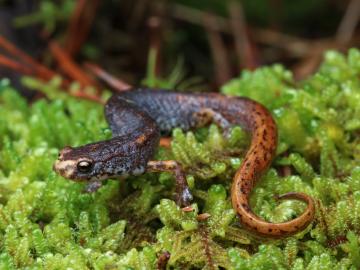
Filter News
Area of Research
- (-) Biology and Environment (129)
- (-) Electricity and Smart Grid (3)
- Advanced Manufacturing (5)
- Biological Systems (2)
- Biology and Soft Matter (1)
- Computational Engineering (2)
- Computer Science (8)
- Energy Science (138)
- Functional Materials for Energy (1)
- Fusion and Fission (6)
- Fusion Energy (1)
- Isotopes (1)
- Materials (61)
- Materials for Computing (7)
- Mathematics (1)
- National Security (26)
- Neutron Science (19)
- Nuclear Science and Technology (2)
- Quantum information Science (3)
- Sensors and Controls (1)
- Supercomputing (83)
News Topics
- (-) Bioenergy (46)
- (-) Clean Water (11)
- (-) Composites (5)
- (-) Environment (92)
- (-) Exascale Computing (4)
- (-) Frontier (4)
- (-) Grid (6)
- (-) Machine Learning (10)
- (-) Microscopy (10)
- 3-D Printing/Advanced Manufacturing (11)
- Advanced Reactors (1)
- Artificial Intelligence (10)
- Big Data (10)
- Biology (74)
- Biomedical (16)
- Biotechnology (14)
- Buildings (3)
- Chemical Sciences (12)
- Computer Science (19)
- Coronavirus (13)
- Critical Materials (1)
- Cybersecurity (1)
- Energy Storage (8)
- Fusion (1)
- High-Performance Computing (21)
- Hydropower (8)
- Isotopes (2)
- Materials (13)
- Materials Science (7)
- Mathematics (4)
- Mercury (7)
- Microelectronics (1)
- Molten Salt (1)
- Nanotechnology (7)
- National Security (3)
- Neutron Science (4)
- Nuclear Energy (1)
- Partnerships (6)
- Physics (2)
- Polymers (2)
- Security (2)
- Simulation (16)
- Summit (10)
- Transportation (3)
Media Contacts

Wildfires have shaped the environment for millennia, but they are increasing in frequency, range and intensity in response to a hotter climate. The phenomenon is being incorporated into high-resolution simulations of the Earth’s climate by scientists at the Department of Energy’s Oak Ridge National Laboratory, with a mission to better understand and predict environmental change.

Oak Ridge National Laboratory researchers developed a model framework that identifies ways to ensure wildlife can safely navigate their habitats while not unduly affecting infrastructure.

Growing up exploring the parklands of India where Rudyard Kipling drew inspiration for The Jungle Book left Saubhagya Rathore with a deep respect and curiosity about the natural world. He later turned that interest into a career in environmental science and engineering, and today he is working at ORNL to improve our understanding of watersheds for better climate prediction and resilience.

With the world’s first exascale supercomputer now fully open for scientific business, researchers can thank the early users who helped get the machine up to speed.

Oak Ridge National Laboratory researchers recently demonstrated use of a laser-based analytical method to accelerate understanding of critical plant and soil properties that affect bioenergy plant growth and soil carbon storage.

Researchers at the Department of Energy’s Oak Ridge National Laboratory are supporting the grid by improving its smallest building blocks: power modules that act as digital switches.

Scientist-inventors from ORNL will present seven new technologies during the Technology Innovation Showcase on Friday, July 14, from 8 a.m.–4 p.m. at the Joint Institute for Computational Sciences on ORNL’s campus.

In a discovery aimed at accelerating the development of process-advantaged crops for jet biofuels, scientists at ORNL developed a capability to insert multiple genes into plants in a single step.

When reading the novel Jurassic Park as a teenager, Jerry Parks found the passages about gene sequencing and supercomputers fascinating, but never imagined he might someday pursue such futuristic-sounding science.

Shih-Chieh Kao, manager of the Water Power program at ORNL, has been named a fellow of the American Society of Civil Engineer’s Environmental & Water Resources Institute, or EWRI.


